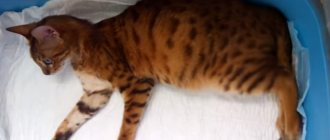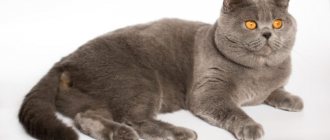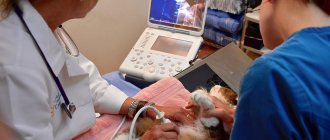How long does pregnancy last in Scottish cats?
The condition of a pregnant cat directly depends on environmental conditions, the presence or absence of stress factors. In unfavorable conditions, the duration of pregnancy in Scottish Folds can be reduced to 58 days, but this has a detrimental effect on the health of future babies.
A healthy representative of the Scottish Fold breed usually bears cubs for 60 to 65 days. When the owner of a Scottish Fold cat asks the doctor how long the animal’s pregnancy lasts, he should be ready to talk about the health and behavioral characteristics of his pet. The duration of gestation of kittens depends on many conditions:
- the presence or absence of obesity in the expectant mother;
- age: young Scottish Folds (up to a year) often encounter problems when bearing kittens;
- intensity of hormonal fluctuations;
- the presence of infectious diseases: a sick mother may give birth to premature kittens or have a miscarriage.
Important! With a large number of embryos, labor begins earlier. Cases have been recorded when expectant mothers with many children (3 or more kittens) gave birth to offspring after 60 days of pregnancy.
Very rarely, pregnant Scottish Fold cats go 70–75 days before giving birth. This happens due to genetic predisposition or individual characteristics of the body.
Determining the term of a pet
When mating is carried out under the supervision of a specialist, the day of fertilization is easily calculated by adding a couple of days to the date of the event. Further, the period is calculated from the received number.
When an animal conceives on its own at an unknown time and with an unknown partner, only a specialist can determine the period during examination. The owner can estimate approximately by the belly, when it is large, then the period is around two months, but when it is not yet visible, and the nipples are already pink, that is, for about a month.
In cats, the full pregnancy period, which is approximately two months, is divided by specialists into 3 trimesters, each of which has a duration of 3 weeks and its own characteristics.
What is characteristic of the initial trimester?
About a day after a female mates with a male, the sex cells are the first to be fertilized and implant inside the uterus. After one week, the embryos grow to the size of tiny grains of sand, and fertilized eggs with embryos are formed.
Every embryo has a personal space in the uterus, designated in advance by nature. This attachment position determines the sex of the future kitten (see how to determine the sex of a kitten). Every embryo is placed in the chorion, which is placed in the placenta.
It also has small villi, the number of others varies depending on the speed of fetal formation. If these flagella in embryos of opposite sexes get mixed up, then kittens of the middle sex are likely to be born.
Approximately two weeks after fertilization, the embryo reaches a length of 10 mm, on the 18th day the limbs are formed, and by three weeks the internal organs are formed, it is at this time that the nipples of the expectant mother become pinker.
How does the middle trimester go?
During this period, the baby’s skeleton, their muscles, brain and hormone production structures are formed.
The embryo transforms into a fetus and already looks like a kitten. By the end of this trimester, the baby’s face with its nose, mouth and cheeks in their places is finally formed. The first molars erupt in the oral cavity, the skeletal system gains calcium, and claws appear. At this time, the appearance of genital organs occurs in babies.
Features of the final trimester
By this moment, the cubs should have a length of at least 8 cm, the tail grows, the ears become larger, and the skin becomes thicker. By the 45th day, the fur grows, and after another three days it gets its color. The baby's length is already approximately 13 cm. By the 57th day, he is already fully formed and is just waiting for the time of birth.
Preparing a Scottish woman for pregnancy
Before planning a breeding, the owner of a Scottish Fold cat should know when she might go into heat. As a rule, this happens in the 9th month of the furry beauty’s life. But mating during this period is not recommended. This age is considered a period of early sexual maturity: the animal’s body has not yet fully matured. It is better to postpone this event until the age of one year, or at least until the 3rd heat.
Before becoming pregnant, a Scottish Fold cat must:
- Provide the expectant mother with a fortified diet.
- Treat your pet against external and internal parasites.
- Give the animal vaccinations.
- Choose and equip a warm and secluded place without drafts for the future family, and accustom the cat to it in advance.
- Pay attention to the health of the future father of newborn babies.
Important! The way a Scottish woman eats cannot be changed after pregnancy. If the food was dry, then it should be fed to the expectant mother, subject to the veterinarian’s recommendations.
At what age can you knit tartan?
The age of the first heat in Scottish females is 8-10 months. But you shouldn’t rush to find a successful cat partner right away. It is better to wait until your pet is at least a year and a half old. Otherwise, if a cat becomes pregnant while very young, misfortune may occur - stillborn or weakened babies. Sometimes early birth even entails the death of a young mother.
By the way, before the first heat or after it (it is important that the cat is more than six months old), you can contact a veterinarian to remove the purr’s ovaries. This operation will save the cat from becoming pregnant, and the owner will not have to worry about problems while bearing babies.
How to detect early pregnancy
As a rule, signs of pregnancy in a Scottish Fold cat can only be diagnosed after 2-3 weeks. But they are individual for each animal and may not be noticeable in the early stages.
Modern science does not yet have tests to determine the fact of fertilization in animals. Symptoms that indicate your pet is pregnant:
- morning sickness;
- swelling of the nipples, change in their color (they turn pink);
- increased appetite;
- change in food preferences;
- changing habits;
- tendency to apathy;
- increasing the duration of sleep periods.
Important! Due to the genetic characteristics of the Scottish Fold breed, they mate exclusively with straight-eared partners (Scottish Straight). This practice guarantees the birth of healthy and strong offspring.
Mating
At approximately 8-9 months, the cat reaches puberty. However, the most suitable time for mating is the age of 1.5 -2 years. Cats are usually not bred during their first heat, since their bodies are not yet physically or mentally ready for pregnancy and childbirth.
It is better to pair her with a cat on her 2nd or 3rd heat. You should be very careful when choosing a partner for future mating. A fold-eared cat can only be crossed with a straight-eared Scotsman.
It is important to know that it is forbidden to cross a fold cat with a fold cat. As a result of such mating, sick offspring with various defects and defects may be obtained. A miscarriage is also possible.
For the first mating, it is necessary to select a more experienced male who has already had offspring. He must be well-groomed, have a healthy appearance, uniform coloring and trimmed nails.
A pedigree and a passport with vaccinations are required. A specialized Scots breeding club will help you find a suitable partner. Experienced specialists will advise and help you choose the most suitable cat in terms of parameters and external characteristics.
Nuances and possible complications
Scottish Fold cats that bear kittens require special supervision from the owner. To avoid complications and maintain the health of the furry beauty and her offspring, the owner of the animal should invite a veterinarian if he notices the following symptoms:
- complete lack of appetite in the cat for more than 2 days at the beginning or middle of pregnancy;
- the appearance of discharge long before birth;
- fever, lethargy;
- the gestational age exceeded 68 days.
Attention! If labor begins in a cat 2-5 days earlier, you need to call a doctor at home.
False pregnancy
Each Scottish Fold has its own type of nervous organization and individual hormonal background. Under the influence of unfavorable factors, symptoms of a so-called false pregnancy may develop:
- the appearance of discharge from the vulva;
- frequent licking;
- enlargement of the abdomen and nipples;
- onset of lactation;
- increased and then decreased appetite;
- bowel disorders.
Treatment in this case is prescribed only by a doctor. Before contacting a specialist, you should limit your cat's intake of milk and reduce food portions.
Frozen pregnancy
The viability of the cubs is determined by the doctor after 2 weeks after fertilization. If there is a suspicion that the embryos have died, the animal is given an ultrasound.
The causes of missed abortion are usually infectious diseases, hormonal disorders, and pathological processes. Not all embryos may die, and then they do not interfere during pregnancy, and the mother gives birth to non-viable cubs along with the living ones.
If a Scottish Fold cat is diagnosed with a frozen pregnancy with complete death of kittens, the animal is induced to give birth and all pregnant cubs are removed. This must be done to save the mother from infection with decomposition products. If postoperative complications develop, the animal is sterilized.
Superfetation
Scottish Fold cats can go into heat even if they are already pregnant. Repeated sexual contact with the same partner (superfetation) in such animals leads to the beginning of a parallel process - a second pregnancy. It occurs simultaneously with the first. Another male can also fertilize a cat for the second time - this is called superfecundation.
In most cases, this situation ends badly - with a miscarriage or the death of one of the litters. Even if a cat carries and manages to give birth to all the cubs, it will be very difficult for her to feed the offspring. Therefore, it is very important to isolate the expectant mother from adult cats.
What are the dangers of early pregnancy?
Despite the fact that teenage cats are physiologically capable of giving birth as early as 7–8 months, experts recommend against mating such young animals. Scottish Fold cats that are under one year of age often give birth to weak or dead kittens, no matter how much care they take.
After such stress, the animal takes a long time to recover, rarely recovering earlier than after 6 months. If a cat develops complications due to an unsuccessful birth, she will need long-term therapy, and possibly sterilization.
Harbingers of childbirth among sphinxes
Don and Canadian Sphynxes are exemplary and caring mothers for their little kittens. The gestation period lasts from 58 to 72 weeks. In most cases, cats of this breed produce from 3 to 5 kittens per lamb.
The first signs of the onset of labor in sphinxes appear 2 days before the upcoming event. Two days before the onset of labor, the body temperature in the rectal canal drops to 36.7 degrees. The cat begins to actively groom and wash the genital area.
A few hours before giving birth, the cat begins to arch its back and show pronounced anxiety. Otherwise, the signs of beginning labor are similar to other cat breeds, and the birth process itself takes about 12 hours before the last kitten emerges.
Note! If your pet's contractions last longer than 3-4 hours without pushing, you should contact a veterinarian for help.
Features of the first pregnancy
Pregnant Scottish women behave very carefully, avoiding conflicts and active games. They do not strive to go outside and instinctively limit their physical activity.
Primiparous animals require additional attention. It is very important to properly organize your pet’s nutrition:
- feed several times a day in small portions;
- use specialized feed;
- control the animal’s weight and avoid overfeeding.
Do not be surprised if at 8 weeks of pregnancy the expectant mother begins to look for a place for a nest. In her desire to make herself more comfortable, she can create a mess in her wardrobe. A loving owner prepares a bed for the future family in advance and accustoms the cat to it.
Interesting! If a primiparous cat at 9 weeks of pregnancy does not eat for a day or two, there is no need to panic. This is how the animal prepares for childbirth.
Stages
Let's pay attention to a brief description of the animal's condition at different weeks of pregnancy:
- 1 Week. The pregnancy of a Scottish Fold cat is almost impossible to notice. The nipples swell slightly and their color changes, but even experienced breeders find this difficult to notice.
- In the womb of the expectant mother, fetuses are already being formed, their number and the sex of the babies have been determined. Cell division after fertilization occurs after 60 hours. Division continues every 12-14 hours. Around day 4, small clusters of cells form, from which the future baby will form.
- Week 2. Using an ultrasound machine, the doctor can already determine whether the cat is pregnant or not. Experienced breeders can feel the fruits with their fingers, but this should be done extremely carefully so as not to harm future kittens.
- Palpation is strictly not recommended for novice owners! The fetuses in the womb are still small, but are actively developing.
- Week 3. It is during the third week that cats begin to experience morning vomiting. It usually lasts no more than a week. This stage of pregnancy is interesting because the Scottish cat exhibits an interesting feature - superfetation. This is the repeated mating of a cat with a cat, perhaps not even the father of the future kittens.
- Superfetation is extremely rare in humans, but it is quite possible in every tenth cat. But in order to mate again, you need to be in heat, the inquisitive reader will tell you. Right! But it can be triggered by many factors.
- 4 and 5 weeks. At this stage of pregnancy, the cat's behavior changes dramatically. In addition, at 4-5 weeks there is a high chance of miscarriage, so it is extremely important that the Scottish Fold cat approaches pregnancy absolutely healthy.
- Babies develop bones, although they are still made of cartilage. Muscles, teeth and genitals develop. The babies can hear their heartbeat. By the end of the 5th week, the fetuses completely occupy the uterus. The skeleton is strengthened, most of the internal organs are formed.
- 6 and 7 weeks. By this time, the cat becomes noticeably fatter and activity subsides. But a pet can fall from a height and damage its offspring. The pregnant mother should be especially closely monitored.
- It is difficult for a cat to take care of personal hygiene; its stomach prevents it from licking its fur and organs. After visiting the toilet, the owner should take a cotton pad and wipe the pet. The cat begins to eat less, preparing itself for childbirth. Kittens develop fur in the womb, they have grown significantly and are actively moving in the stomach.
- Weeks 8 and 9. The cat is actively preparing for childbirth. He sleeps a lot and is not active, sometimes trying to find a secluded place to give birth. It is not difficult to prepare a “maternity ward” in an apartment in advance, but this should be taken care of in the first weeks of pregnancy.
Including private presence next to the cat. There have been cases when the residual, but strong and constant smell of a male, which came from the clothes of the owners, provoked estrus in a Scottish cat.
If this happens, there are several possible scenarios:
- the offspring will die completely;
- babies born after the second conception will not survive;
- the cat will give birth to both litters, but they will be weak and will require additional strength to deliver them. A cat cannot do this alone. The embryos develop a body, head and internal organs. You can even see a small tail!
Color-point kittens are monochromatic in the womb. The color depends on the temperature of the area of the body where the fur grows. Inside the cat's mother, the temperature is uniform, but after giving birth, the color of the kitten's fur changes. He independently regulates his body heat. If the gestation period has exceeded 70 days, the owner should contact a veterinarian.
Pregnancy calendar for Scottish cats by week
An experienced veterinarian can diagnose the onset of pregnancy in a domestic Scottish female within 14 days after fertilization. If you know the exact date of mating, you can easily determine the stages of development of the process.
The entire period of pregnancy of a Scottish fold cat is conventionally divided into 3 parts (trimesters):
- The first one is up to 3 weeks. The cat refuses its usual treats and vomits in the morning. The appearance of the animal remains unchanged.
- Second – 4–6 weeks. Fluctuations in hormonal levels begin, which causes bursts of unusual animal behavior (aggression or, on the contrary, an excessive need for affection). The cat's belly becomes rounder, it begins to eat more, and its weight increases. The physical activity of the animal is noticeably reduced.
- The third – from 6 weeks until birth. The expectant mother is increasingly showing anxiety and likes to settle down in secluded places to rest. The size of the abdomen increases, the nipples swell greatly. If you put your hand on the stomach, you can feel the kittens move. At week 9, colostrum appears.
While the Scottish female is bearing offspring, she needs special treatment: it is not recommended to pick her up or allow her to climb onto high surfaces. The cat must be provided with a high-calorie and balanced diet.
Symptoms and signs
After mating, it is possible to determine if a cat is pregnant only after 3-4 weeks. Previously, it did not appear in any way. Some symptoms:
- The cat's behavior changes, it becomes cautious and less active.
- Sometimes nausea is observed, and temporary refusal of food is observed.
- Later, on the contrary, appetite increases. The animal eats a little, but often.
- If the cat is pregnant for the first time, changes in the nipples can be seen in the second month. They increase in size and swell. Now they can be easily felt.
- The belly gradually rounds and grows.
The animal becomes less active
Not all cats will necessarily have the same characteristics. No two animals are the same, and their symptoms of pregnancy are different. Slender cats often give birth on time, while well-fed cats carry them to term. Also, the period depends on the number of fruits. If there are many of them, birth occurs later.
At a later stage, you can place your palm on the cat’s stomach and feel the kittens move. But you don’t need to put too much pressure on the stomach so as not to harm the offspring.
Caring for a pregnant cat
It is necessary to try to eliminate factors that cause stress from the animal’s life. For example, if before pregnancy a Scottish fold cat walked freely alone, you should not prohibit her from such walks during pregnancy.
You cannot treat an animal with chemicals without a veterinarian’s prescription or vaccinate it. This can have a detrimental effect on the health of both mother and offspring.
The food must be exclusively fresh. From the second trimester of pregnancy, portions begin to gradually increase, this continues until the end of the first month. Then the amount of feed is gradually reduced until the initial volume is reached by week 9.
Important! A pregnant cat's meals should be divided, she is fed 5 times a day.
If the expectant mother is accustomed to a natural diet , it needs to be diversified with vegetables, herbs, vegetable oil, cereals, and eggs. From time to time you can pamper your cat with sea fish (pre-boiled). Rabbit, veal, and poultry are very healthy. It is allowed to support your pet’s body with multivitamins.
There are ready-made foods for pregnant cats on the market. The Scottish cat needs exactly these products if she initially ate dry formulas. It is better to purchase extra-premium food.
For your information! Treating cats for parasites during pregnancy is prohibited.
Recommended Products
The diet largely depends on age and personal eating preferences. But regardless of this, a Scottish woman should consume the following types of foods.
Squirrels. They should be an essential component of nutrition, as they ensure the development of all types of tissues and muscles. Proteins of plant and animal origin must be present in the diet. It is necessary to give your favorite lop dog lean turkey, beef or chicken every day.
Fermented milk products such as kefir, cottage cheese, fermented baked milk and yogurt improve digestion and provide the body with calcium. It is an important component in the formation and strengthening of the skeletal system, teeth and claws.
Such products can be given in small quantities, and preferably low-fat or with a small percentage of fat.
Vegetables. Almost all types of vegetables will be well digested and absorbed in the pet’s body. The exception is white cabbage, which causes fermentation and stagnation in the stomach.
Vegetables should only be served boiled. They can also be grated and added to meat.
Cereals. Oatmeal is best. It improves digestion and stimulates intestinal function. Rice can cause constipation. Therefore, it is better to focus on the preferences of the cat itself.
Fish. During pregnancy, it is better to exclude it from the diet. But you can give small amounts of salmon, trout, mackerel or sardine meat, which contains fat-soluble vitamins.
Important: Vitamin and mineral supplements should only be given on the recommendation of a veterinarian.
If a Scottish woman prefers to eat ready-made food, then the best of them will be premium or super-premium class, created specifically for pregnant women.
Cheap food will not do any good. Due to the insufficient content of vitamins and minerals in it, her health may deteriorate.
Preparing for childbirth
In a house where a Scottish woman expecting offspring lives, you should not rearrange the furniture or play loud music. Purchasing new pets is also undesirable. All this will irritate the cat and can provoke premature birth. The litter in the cat corner needs to be changed regularly.
It is necessary to enlist the support of a veterinarian so that in case of an unforeseen situation he can go to your home.
As a rule, cats cope with childbirth on their own. But a weakened Scottish woman or a Scottish woman giving birth for the first time may need help. At the time of birth, it is worth preparing some tools: scissors (to cut the umbilical cord), iodine to disinfect the wound, an old diaper (to wipe kittens), a small syringe to remove mucus from the noses of newborns.
Assistance during childbirth
It is impossible to determine exactly how long pregnancy lasts in Scottish Fold cats. The process continues until the cubs are fully mature. A harbinger of the onset of labor is a decrease in the cat's rectal temperature. This happens about a day or 12 hours before birth.
When the water breaks and contractions begin, the owner of the animal should be nearby to help the woman in labor if necessary. The cat should be placed on a clean cloth with a diaper placed under it, and the tools should be prepared. A warm heating pad and Vaseline may be needed.
If the process is going slowly, you need to help the cat: lightly pull the cub by the withers when its head and shoulder blades become visible. Hands should be pre-treated with Vaseline.
After the birth of the first baby, its umbilical cord is cut 2 cm from the abdomen, tied with thread and the wound is disinfected. The babies are placed next to the mother's nipples so that she can lick them and feed them. Fed kittens are wiped with a dry cloth and placed on a clean towel, under which there is a warm heating pad.
If a cat cannot deliver the placenta on its own, the owner must remove it. In case of prolonged (more than 20 hours) and inconclusive contractions, you need to invite a doctor. After the birth is completed, it will not be superfluous to count the placenta: there should be as many of them as newborn kittens.
To protect the mother and babies from stress, it is advisable to postpone receiving guests and moving for the lactation period until the kittens are stronger. The family needs peace and temporary isolation from other animals and children.
Regardless of the amount of time that Scottish Fold cats brood, their kittens may be born healthy or weak. The main factors that influence the success of the business are the health of the expectant mother and her owner’s awareness of the rules of proper care for a pregnant cat. An affectionate attitude towards the animal and the organization of a calm and cozy environment for the future cat family play a huge role.
How to help a Scottish woman during childbirth
The first aid before lambing is preparing the den. The simplest option is a cardboard box with holes cut for ventilation, lined with paper and covered with a soft cloth. The future house for kittens is placed in a secluded place. The nesting cat is picked up and placed in a prepared place. If the cat shows willfulness and lambs in another place. She, along with her offspring, is placed in a prepared den, from which she will never leave.
It is good if a veterinarian is present during the birth, but most owners can provide assistance on their own. Most often, the cat copes on its own.
Labor begins with the release of amniotic fluid. The kitten is born in the amniotic sac, which bursts and the cat gnaws the umbilical cord. If she did not do this, you need to cut the cord with sterile scissors and treat the stump with tincture of iodine. The mother usually eats the placenta. This is normal, but you should not allow more than two placentas to be eaten. When the cat has the intention of eating another afterbirth, food is added to it.
If the bubble does not open on its own, it is broken with your fingers. The kitten is shaken, the liquid is removed from the mouth with a baby syringe and placed on the mother.
The normal interval between the births of kittens is considered to be a quarter of an hour. All afterbirths come out within half a day after the birth of the last kitten. If labor is difficult, call a veterinarian.











